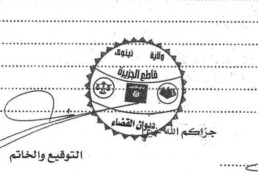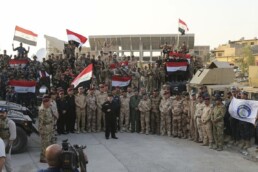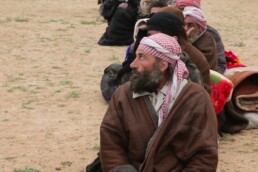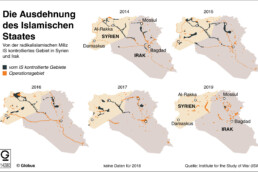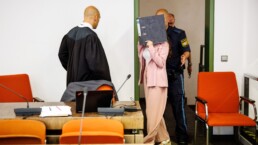Islamic State (IS)
About
On 3 August 2014 IS attacked the city of Sinjar, predominantly populated by Yazidis, and the province of the same name. The date marks the starting point of the ongoing genocide of the Yazidi population.
IS is an international terrorist militia whose declared goal is the establishment of a global caliphate. The first precursor organisations emerged from Al-Qaeda structures in Afghanistan in the early 2000s. In October 2006, the jihadist terrorist organisation Al-Qaeda in Iraq (AQI), which had previously committed numerous attacks on civilians, renamed itself Islamic State in Iraq (ISI) and declared its supposed claim of rule to Kurdish areas in northern Iraq. Various waves of attacks followed in Iraq from 2007 to 2010, killing several thousand.
When on 11 February 2012 Al-Qaeda called on Muslims in Iraq, Lebanon, Jordan and Turkey to fight the Assad government, ISI also participated in the Syrian civil war. In the spring of 2013, al-Nusra Front, a jihadist Islamist organisation in Syria, and ISI united under the auspices of Al-Qaeda to form the Islamic State in Iraq and Syria (ISIS).
From July to September 2013, the militia carried out various attacks in Iraq and Syria. During this time, jihadist fighters from all over the world increasingly travelled to the area.
After the terrorist militia took control of large parts of Syria and Iraq, the caliphate was proclaimed in June 2014. They changed their name to Islamic State (IS). But after that, their former name ISIS has still been used by others and at international levels. From Raqqa in Syria and Mosul in Iraq, the terrorist organisation tried to set up state-like structures. In contrast to other terrorist organisations, IS also increasingly called on women to travel to the alleged Caliphate and bring their children.
Since 2015, the terrorist militia has also increasingly committed attacks in Europe, including the attack on the Bataclan Theater on 13 November 2015 in Paris and the attack in Nice on 14 June 2016. Although the terrorist organisation has a more classic military strategy than its predecessor organisations, terrorism is one of its main weapons of war.
Since 2017, IS has been increasingly pushed back by a military coalition between Kurdish forces, the Iraqi army and the US army. In July 2017, Mosul, the capital of IS in Iraq, was liberated. In September of the same year, with US support the Kurdish dominated SDF (Syrian Democratic Forces) finally liberated Raqqa, the centre of IS in Syria. Since then, the Islamic State has been in military retreat.
In 2021 and 2022, the terrorist militia gained strength in various areas, especially in Afghanistan.
Significant terrorist attacks have occurred in Afghanistan during the last two years since the Islamic State competed with the radical Islamist Taliban due to the existing power vacuum in the country. IS sleeper cells have become active again in Syria and Iraq.
Ideology
In 2007, the terrorist organisation published a pamphlet titled ‘Notifying Believers of the Birth of Islamic State,’ attempting to substantiate a caliphate’s alleged legitimacy. However, the claim is not limited to just one geographical area, although the Islamic State often states this in its propaganda videos. Instead, according to IS ideology, a caliphate should be proclaimed wherever its fighters publicly appear with weapons.
Muslims are the world’s largest group persecuted by IS. Since most Muslims practice a different interpretation of Islam, IS denies them their status as believers and declares them so-called kaafir, which means infidels or deniers of God. Shiites, in particular, are hated and persecuted by IS because they can not convert to the terrorist organisation’s ideology.
Another central aim of IS is the cultural and religious erasure of the identity of the Yazidis. Yazidis are regarded by IS and other Islamist groups as alleged devil worshipers because they worship Tausî Melek, the angel peacock, whom IS interpreted as a fallen angel, i.e., the devil. The terrorist organisation uses this interpretation as a pretext for the ongoing genocide against the Yazidis and the associated murder and enslavement of the Yazidi population since 2014.
We were forced to make the Islam confession. An ISIS man recited, all women had to repeat.
— Survivor, 18 years-old. In: About Life/ Survival. Female Yazidis after the Femicide 2014 (touring exhibition), p. 21.
IS ideology can not be understood without looking at conspiracy ideologies to which their propaganda repeatedly refers. Anti-Semitic motives regularly play an important role in the terrorist organisation’s fake news. A repeatedly emphasised goal of the Islamic State is annihilating the State of Israel and the entire Jewish population. Jews are defamed in the Islamic State ideology as a closed group that supposedly rules the world. Western politicians are referred to in this context as puppets or so called mules’ of the Jews. It is claimed that Jews try to dissuade Muslims from their faith.
These are not just elements of a classic anti-Semitic narrative. They also provide the basis for IS supporters to display themselves in a constant defensive attitude towards the West or the westernised world. All elements that are identified with Western life or modernity – the increasing equality of the sexes, freedom of expression of (homo)sexuality, revealing fashion or the increasing softening of the traditional family role models – are used by IS propaganda as allegedly threatening the traditional way of life contrasted by IS.
In this context, the deprivation of the rights of women, whom Shari’ah severely restricts in public and private life, is a particular focus.
Shari’ah is the Islamic law that forms the basis of life in the caliphate. It comprises various codes of law and provides the basis for judicial and extrajudicial decisions, legal norms and interpretations of the law. For example, IS used Shari’ah as a justification for the discrimination, persecution and murder of so-called infidels and used it as a pretext for the ongoing Ferman against the Yazidis. However, as defined by IS, Shari’ah is also a justifying element for various regulations within Muslim society.
IS published a 16-point catalogue that banned the consumption and sale of alcohol, tobacco products and other drugs. Public gatherings, possession and use of perceived idols were banned. Women were forced to cover their bodies, hands, face, and even eyes. The Ministry of Propaganda also censored mosque announcements. The breeding of pigeons was banned because IS considered it sexually offensive. There were also precise regulations on mobile phones, which served to monitor and control the caliphate’s population.
In the interpretation of IS, violations of these Shari‘ah ordinances are punished with draconian punishment, especially corporal. Scores of people were publicly mutilated, flogged, or executed within the caliphate. These practices also serve to deter the population and are a display of public terror within the caliphate.
Structures and Perpetrators
In the distance, I saw three men dressed in black. (...) These ISIS men came in cars, surrounded us, had rifles, and separated older people from younger ones.
— Survivor, 12 years-old. In: About Life/ Survival. Female Yazidis after the Femicide 2014 (touring exhibition), p. 12.
The head of state of the self-proclaimed caliphate was Abu Bakr al-Baghdadi (real name Ibrahim Awad Ibrahim al-Badri) from its founding until he died in 2019. On the one hand, he was the caliph of the Shura Council, an administrative body consisting of a total of nine advisors (called ulama) and his two deputies, Abu Muslim al-Afai al-Turkmani (real name Fadil Ahmad Abdullah al-Hiyali) and Abu Ali al -Anbari (real name Adnan al-Sweidawi), which was primarily responsible for the administration and structural development of IS. On the other hand, the Shari’ah Council, which was hierarchically equal to the Shura Council, was directly subordinate to it. In it, at least six religious leaders discussed ideological interpretations within the caliphate. The caliph had ultimate decision-making power in both the Shura and Shari’ah Councils. He was also responsible for the direct appointment of key officials within IS. He appointed the chief judges, administrative heads, military officials and the chief of the police apparatus.
The political administration of IS was divided into different areas. The finance department drew up budgets and distributed funds. In addition, it was responsible for administering foreign donations and financial transactions through which the Islamic State was financed since it did not have a self-sufficient economy. This area of responsibility makes it clear that the terrorist organisation depended on foreign supporters and networking and would not have been able to independently maintain the years of war and terror in the region and worldwide without this support.
The military apparatus was responsible for planning and conducting military operations. It also commanded the conduct of hostilities of the fighters. It was supplemented by a separately administered Fighters Assistance Council, which took care of disability pensions and payments to the wives and widows of IS perpetrators and, in some cases, their accommodation. IS operated a regulated and institutionalised system.
The management department was subordinate to the heads of administration appointed by al-Baghdadi, who were responsible for education, health and agriculture.
The judicial system was divided into three different areas, each of which was presided over by a supreme judge: a legislative area, which was intended to give the impression of modern separation of powers, a social area (public law), and an area for private individuals (civil law), negotiating over divorce or adultery.
The police apparatus was subordinate to the Security Department. This area of responsibility included public controls and criminal investigations, often marked by violence and arbitrariness. The female police who abused and arrested women for alleged or actual violations of Shari’ah guidelines within the caliphate were also part of this area.
The secret service covered not only foreign operations, such as planning international terrorist attacks or smuggling terrorist IS fighters, but also secret police tasks, such as uncovering and suppressing alleged or actual resistance movements. In addition, the secret service worked closely with the police and the IS media department, primarily responsible for creating and disseminating propaganda inside and outside the caliphate. The media department was a highly professional propaganda industry, which at great expense created a broad and technically modern range of media glorification of terror; fixed formats for spreading fake news and hate speech, and jihadist entertainment industry.
The Ummah Council is a body repeatedly advanced through IS propaganda. Ummah describes the community of Muslims worldwide and the Muslim people’s representatives in the political system of the caliphate. In the case of IS, it is a question of a politically largely powerless legitimacy figure intended to give the impression of separation of powers and democratic control within the caliphate. However, the structures can be described as autocratic to partially oligarchic. The division of the political order continues similarly in the provinces. There is no such thing as federalism in the democratic sense, but it is a delicate institutionalised division of labour that affects public life and has a major impact on people’s private lives. This division of labour represents a central distinguishing feature of IS compared to other terrorist organisations. The up of state structures enabled IS to coordinate and calculate attacks and use of military effectively as well as coordinate and calculate supposedly civilian resources. In addition, for several years, the Ummah Council was able to build up a bureaucratic and collaboratively organised repression apparatus within the caliphate, which is characterised by less reactive than institutionally professionalised oppression practices.
Germans at the Islamic State (IS)
According to the Federal Criminal Police Office, over 1,000 Germans have joined the Islamic State and other jihadist terrorist groups. A quarter of them are women. While the paths to radicalization vary, recruitment was systematic using social media. The Federal Ministry of the Interior counts 80 returnees from the so-called Islamic State. How do Germans come to the Islamic State? What did they do with the Islamic State? The best-known German in IS was probably the rapper Denis Cuspert, who was killed in Syria in 2018. In the following, four German women from the Islamic State who were on trial in Germany will be portrayed.
Jennifer W.
Born 1991 in Lohne (Vechta Region, Lower Saxony)
Jennifer W. converted to Islam at the age of 21 and joined ISIS (later IS) out of ideological conviction. In August 2014, Jennifer W. traveled to Syria to join IS and married IS member Taha A.J. She moved with him to Fallujah (Iraq). There, as in Mosul, she worked armed for the morality police in parks and monitored compliance with the Islamic State’s dress and behavior regulations. In Fallujah, the couple kept a Yazidi woman and her daughter as slaves. The Yazidi woman’s five-year-old daughter died in agony after being chained and exposed to the blazing sun as punishment. In 2016, Jennifer W., pregnant in Turkey, was deported to Germany and finally arrested in Bavaria in 2018 when she tried to travel to IS territory again with her baby.
In the trial at the Munich Higher Regional Court in 2023, Jennifer W. was sentenced to 14 years in prison after an appeal, among other things, for membership in a terrorist organization, crimes against humanity, slavery resulting in death as well as aiding and abetting attempted murder by omission.
Romiena S.
Born in 1988 in Mülheim an der Ruhr (North Rhine-Westphalia)
Romiena S. converted to Islam as a teenager and later met an IS member online. In order to marry him, she traveled to Syria via Turkey with her then 4-year-old daughter at the end of 2014 and joined IS. She lived with her husband in Raqqa. After his death, she married two other IS members. She raised her children in the spirit of IS and even took her 6-year-old daughter with her to the stoning of a woman. In 2016, Romiena S. lived in a slave trader’s house for a few days and knowingly exploited an enslaved Yazidi woman there. Romiena S. made her views public by supporting the IS attacks in Nice and Würzburg on Twitter. At the beginning of 2019, when IS was almost considered to have been militarily defeated, she was detained by Kurdish forces, lived in camps in Syria for two years and was repatriated to Germany on 7 October 2021.
In the trial at the Celle Higher Regional Court in 2022, Romiena S. was sentenced to three years and three months in prison for, among other things, membership in a foreign terrorist organization, crimes against humanity (slavery) and endangering her daughter.
Nadine K.
Born around 1986, lived in Idar-Oberstein (Rhineland-Palatinate)
Nadine K. converted to Islam in July 2013 after marrying her Syrian husband and followed him via Turkey to Syria to join the Islamic State in December 2014. From there they went to Mosul (Iraq), where her husband worked as a doctor for IS. In their villa they ran a shelter for IS women and had a weapons depot. They had been holding a 21-year-old Yazidi woman captive as a slave since 2016 and, considering her their property, took her with them to Syria in the summer of 2016. They forced the Yazidi woman to do housework and look after the children. Nadine K. monitored her and knowingly and inactively allowed her husband to regularly beat and rape the Yazidi woman. On March 8, 2019, Kurdish forces arrested her while escaping Al Baghouz. Nadine K. was taken to a prison camp with her children. On March 30, 2022, they were repatriated to Germany by the federal government.
In the trial at the Koblenz Higher Regional Court in 2023, Nadine K. was convicted, among other things, of membership in a foreign terrorist organization in three cases, one of which included crimes against humanity through enslavement, aiding and abetting genocide through extermination, as well as aiding and abetting war crimes against Persons, human trafficking with serious deprivation of liberty, and sentenced to a total prison sentence of 9 years and 3 months.
Leonora M.
Born around 2000, grew up in Sangerhausen (Breitenbach, Saxony-Anhalt)
Leonora M. joined the Islamic State as a minor at the age of 15 in order to lead a “purely Islamic” life. In March 2015 she traveled to Syria via Turkey and married IS member Martin Lemke. She spent most of her time in Raqqa, where she worked as a nurse in an IS hospital for a few months. At the end of 2015, her husband bought an enslaved Yazidi woman. Leonora M. nursed the woman so that Martin Lemke could resell her at a high price. In January 2019, they surrendered to the Syrian Democratic Forces (SDF) in Al Baghuz and Leonora M. was sent to the Al Hol prison camp. There she changed sides, was threatened by IS and therefore moved to another camp. In December 2020 she came back to Germany as part of a repatriation campaign by the federal government and was arrested at the airport.
In the trial at the Naumburg Higher Regional Court in 2022, Leonora M. was sentenced to two years in prison and three years probation for, among other things, membership in a foreign terrorist organization under juvenile criminal law. The court did not see sufficient evidence to convict her of aiding and abetting slavery and acquitted her. Both sides have appealed against the verdict.

